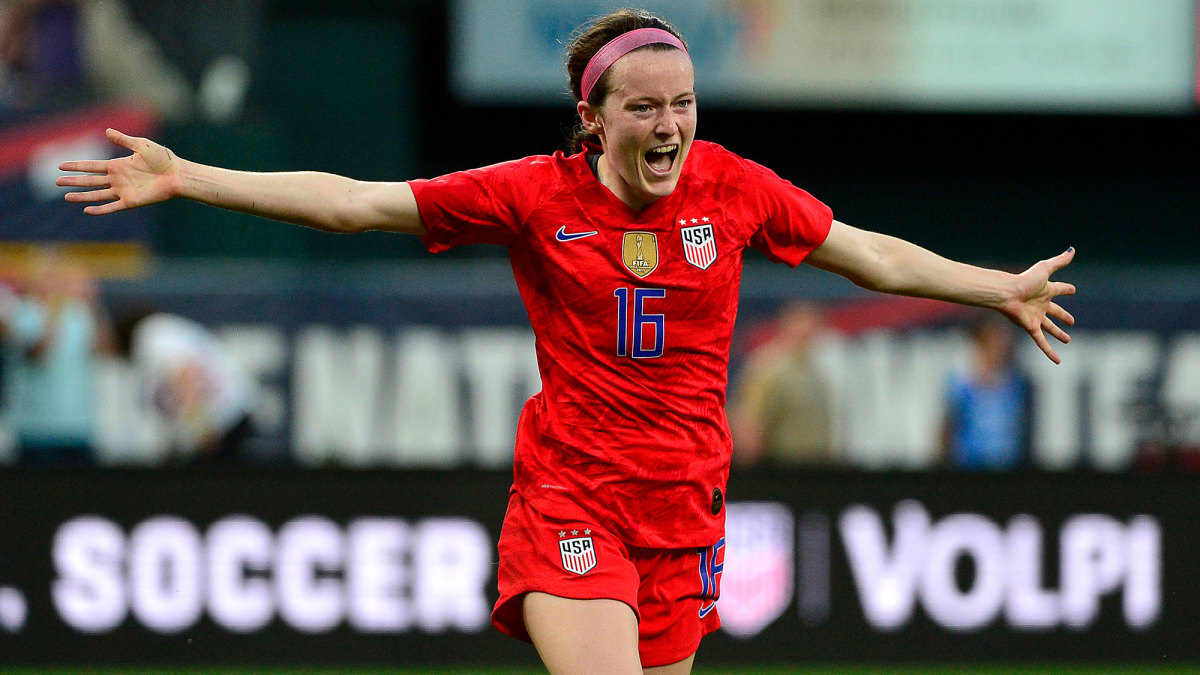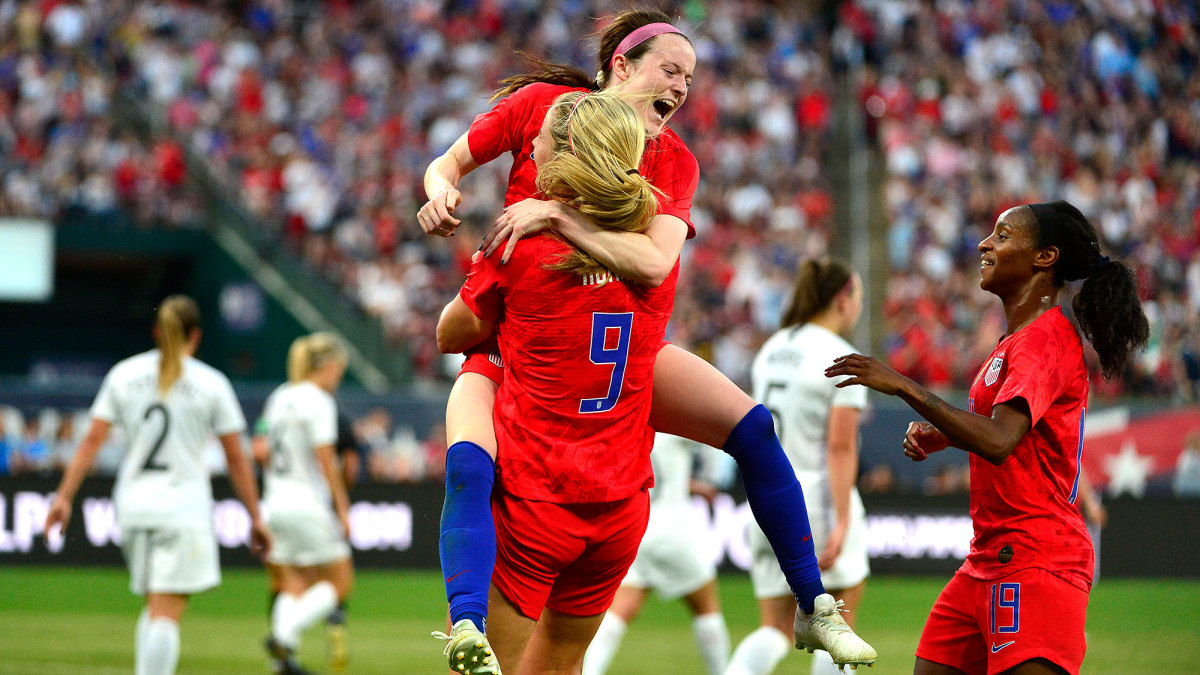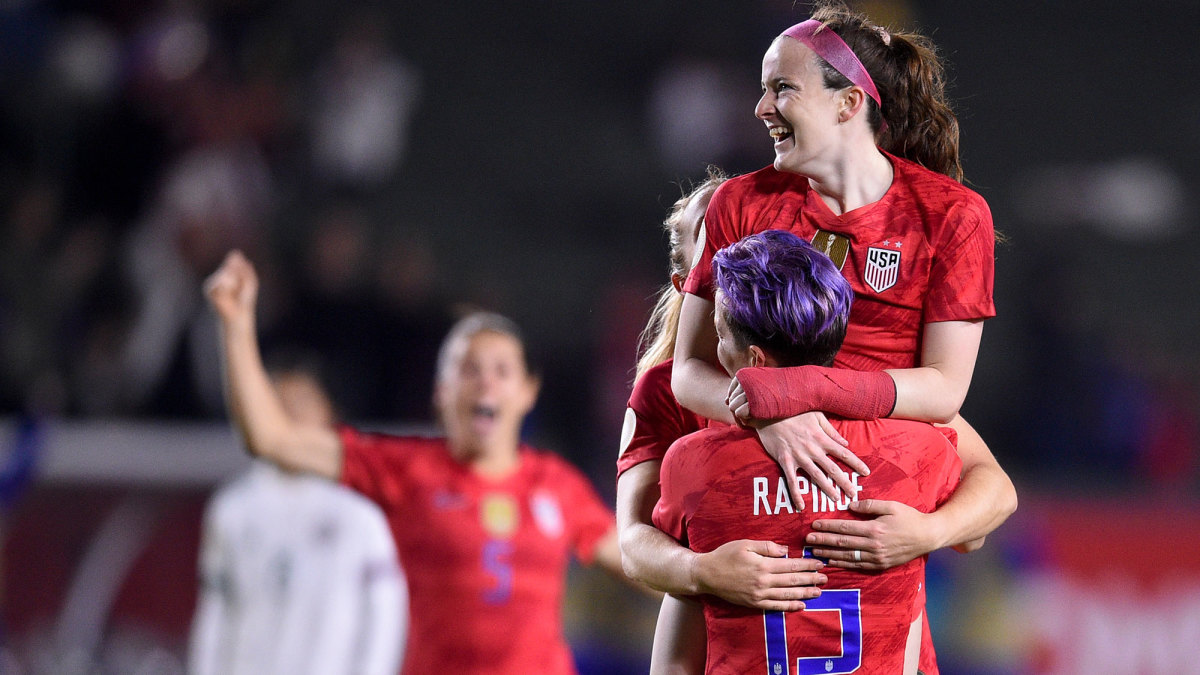How Rose Lavelle Found Her Joy
Rose Lavelle is made for metaphor.
Depending on the day, Lavelle may be an escape artist, wriggling out of tight spots; a virtuoso, known for her creativity; or a trickster, skilled in deceit. She may be a magician, or a technically flawless cyborg, or a purveyor of fine spices focused on nutmeg. At her best, she may be all of these at once. But to be familiar with her work is to understand that the figurative language is necessary. To watch Lavelle play is to feel the limits of any literal vocabulary. She demands new terms.
Lavelle doesn't even have words for it.
“I never know what to say for this question,” she sighs when asked how she describes her game. “I don’t know. I like the creative side. I like to add a little flair when I can. I guess I like to think on my feet?”
In 2019, this spoke for itself—a star-turning run with the U.S. women’s national team in her first World Cup, where she received the bronze ball. She followed with a selection to FIFPro's World XI. And she knows what she wants next: She wants to be better. The 24-year-old does not think that this is her ceiling, or even close to it.
“I still have a long way to go,” she says. “I have a lot to work on. I feel like I’m still pretty rough around the edges.”
If she sounds a bit hard on herself, she probably is. But that’s the foundation here: Rose Lavelle is just getting started.

**********
This week’s SheBelieves Cup marks the third anniversary of Lavelle’s first cap with the USWNT. But her path from there to here hasn’t been linear, and the three-year journey has forced a dramatic shift in how she thinks about her game and her work.
This shift started a few months before that first cap. In September 2016, Lavelle was an All-America senior at Wisconsin with room to grow—she could be inconsistent, and she was always carrying some minor injury—but she still stood out as a promising young talent. She’d trained with the national team before, and then–USWNT head coach Jill Ellis wanted to call her in to finally see some match action.
But Ellis reached out to Lavelle’s Wisconsin coach, Paula Wilkins, first. Wilkins knew her answer: Lavelle was not ready.
Lavelle was furious. (“If looks could’ve killed me at that point,” Wilkins says now, “I wouldn’t be on this earth anymore.”) But Wilkins was confident. She knew Lavelle was talented. But she was exhausted and struggling to care for herself. This was physical—those minor injuries were getting more common—but, perhaps of more concern, it seemed mental, too. There had been a moment in a recent match that had seemed particularly illustrative. Lavelle had dribbled into pressure, been stripped and just stopped. To Wilkins, it was a sign that she had started to crack.
“She had all these expectations,” Wilkins says. “She felt like she wasn’t achieving, and it was this mental burden.”
This wasn’t totally surprising. Lavelle not only had punishingly high standards for herself but was extremely conscious of the standards of others.
“She hates to say no to people,” says her mother, Janet. “She feels like she needs to please.”
To make the national team, Lavelle was told, she’d need to get a handle on this. Learn to deal with the pressure. Listen to her body. Pay attention to recovery. If she didn’t, there was no guarantee that she’d get another chance.
Lavelle zeroed in on taking care of herself physically, spending more time in the training room and focusing on her nutrition. It worked. She was taken with the No. 1 pick in the NWSL draft in January 2017; she debuted with USWNT at the SheBelieves Cup that March; she celebrated her first international goal in April and her 22nd birthday in May. Everything had fallen into place—which made it all the more devastating when she went down with a hamstring injury in June.
Lavelle was sidelined for most of the next year. (She ultimately tore all three muscles in her hamstring.) It was, of course, painful physically, with several failed comebacks. But it was even more difficult mentally.
This was the most time she’d ever spent away from the game. It would have been difficult at any point, but it was especially so in her first year out of college, just as she was learning what it would mean to structure her life as a professional. And when she finally returned, Lavelle realized that her work had only just begun. She wasn’t playing well. She didn’t feel like she could trust herself on the field. That it had started with a noncontact muscle injury meant that she couldn’t pinpoint a particular move, or another player or any other external factor. It was just her. Which meant, really, that she didn’t know who she was anymore.
“Soccer’s always been the thing that brought me joy,” she says. “And then once I came back … then soccer was the source for my sadness and my stress. I didn’t feel like myself. I felt like a huge part of what had always been an emotional outlet for me all of a sudden became the reason for my emotions.”
For a player whose game relied so much on creativity, rather than sheer physicality, this was disastrous. It was a few months into 2018; there was scarcely a year until the roster would be selected for the 2019 World Cup, and Lavelle felt removed from the success that she’d had in early 2017. Physically, she had done all that she could, and it had worked. Mentally, she didn’t understand where she was, or how to get back to where she needed to be. She’d never seriously addressed this part of her game—she’d never needed to—and she didn’t know how to start.
Finally, Lavelle reached out to a sport psychologist. She learned to work with meditating, journaling, visualizing. Slowly, she started to see a way out, and she moved toward it. It was a marked show of vulnerability for a player who’d always been stubborn.
“I don’t think that’s something in the past that she would have ever considered,” says Janet, remembering how headstrong her daughter was even as a baby, relentless in her tries to avoid her dreaded car seat. But in her ask for help, Lavelle got her game—her creativity, her spark, her confidence—back.
“I’ve seen her become more comfortable, and to play like Rose, and that’s to be creative and to make things happen,” says Mallory Pugh, her U.S. teammate and former NWSL club teammate and roommate with the Washington Spirit. “I think that’s definitely come out.”

To maintain her mindset for the World Cup demanded another level of mental strength.
“I thought she could be very good,” says Wilkins, of her expectations for Lavelle before the World Cup, “but it was going to be how she dealt with the pressure.”
The whole experience, Lavelle says, was “mentally trying, just as much as it was physically trying.” While she’d been told to expect this part of the tournament, she was still taken aback by just how difficult it was: “You have to be so high all the time.” But she spoke with her sport psychologist before and after each match in the World Cup, relying on meditation and visualization to keep herself centered, and she handled it better than anyone around her could have expected.
Janet and Rose’s father, Marty, didn’t see much of Rose during the World Cup—there was limited free time for parental interaction—but when they did, she seemed like a different player than the one they’d seen in her youth. For key matches in high school and college, Lavelle would carry stress with her. But at the World Cup? “Almost—I’d almost say, when we’d see her, she’d be joyous,” Janet says. “This is what she’s always wanted to do.”
Her agent, Remy Cherin, echoes that: “She was super free. There was an actual joy.”
Lavelle’s most memorable play of the World Cup was her goal in the final vs. the Netherlands, when she glided down from midfield, raced at defenders and hit a perfect left-footed shot to give the U.S. a 2-0 lead. But her most characteristic play may have come a game earlier. In the first four minutes of the semifinal against England, she swooped down from the top of the box to establish possession; she moved so carefully, so lightly, like she was dancing. She dribbled between a defender’s legs—a soul-sucking nutmeg—and with her intoxicating trademark blend of footwork and inventiveness and sheer gutsiness, Lavelle fired off a shot.
It was blocked. But Lavelle was joyous. Her mind was free.
**********
There is a particular layer of pressure here because the USWNT has never been allowed to be simply a team. Its work is seen as cultural and political just as much as it is athletic. It’s impossible to separate one half of the equation from the other; to step into the spotlight as a breakout star on the field is to step into the center of a weighty social narrative off of it amid the team's ongoing legal battle for pay equal to their male counterparts.
Lavelle is conscious of this, too. But she’s ready to embrace it.
“It’s been so cool to see that we’re not in this fight alone,” says Lavelle. “There are other national teams and other women’s sports that are also part of demanding change and fighting for what they deserve. It’s this unified fight.”
At 24, she’s among the first group of national teammates who were too young to watch the groundbreaking 1999 World Cup. She saw the USWNT in person for the first time at age 10 in 2004, when they played at Paul Brown Stadium in her native Cincinnati.
“You don’t realize—for a little girl who was competing with boys and beating them at a lot of stuff, that they could always have this dream of being an athlete, that they could look up to these sports figures, to want to be a baseball player or a football player—for a little girl not to be able to see that, even though they’re just as good an athlete, I just feel like it’s a huge difference,” says Janet. “To take her there and for her to see that people come to watch these women just like people come to watch the Reds, I think it was huge.”
Lavelle now sees herself in a position to learn from the team’s veterans and most vocal advocates—Megan Rapinoe, Alex Morgan and Carli Lloyd among them—with the realization that she could be in their role next.
“I’m just trying to soak up as much as I can right now while I’m still lucky enough to share the field with them and see them as often as I do,” she says. “And then I’ll take it from there.”

**********
Lavelle’s offseason was profoundly normal. She trained at home in Cincinnati, where she enjoyed quality time with her beloved bulldog, Wilma Jean Wrinkles. She took a brief vacation to Florida. She finished her monthslong quest to catch up on every episode of Law & Order: SVU to watch Season 21 as it airs in real time. If not for the fact that she landed a beer sponsorship (Yuengling) and started to prepare for the Olympics, you could almost be forgiven for forgetting that she was fresh off a breakout year. This is the dream—or would be, if Lavelle didn’t push against the language of “dream.”
“I always have such a hard time putting it into words,” she says. “It was something I believed in and wanted so bad that it was like I never envisioned a future without it. I don’t even like to call it a dream, because it didn’t seem like something that felt unattainable, it wasn’t like I was over-stretching. And it wasn’t like I was, ‘Oh, I’m so good, I’m obviously going to get there.’ Like, I even felt this way when I was a 90-pound freshman in high school and colleges were blowing me off because I was too small. I always had this desire to get there, and I wanted it so bad that I just willed it to happen.”
With another massive international platform ahead in the Olympics, there’s plenty for Lavelle to will her way into next. The question of whether she can someday be the best in the world seems not just fair but maybe even necessary. And whatever the answer, Lavelle should inspire some brilliant metaphors to describe it.
